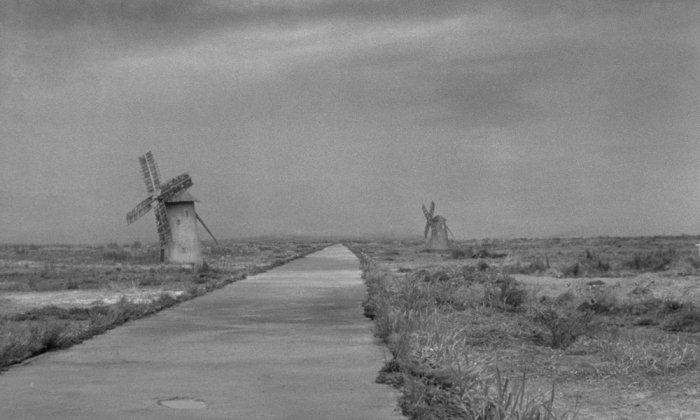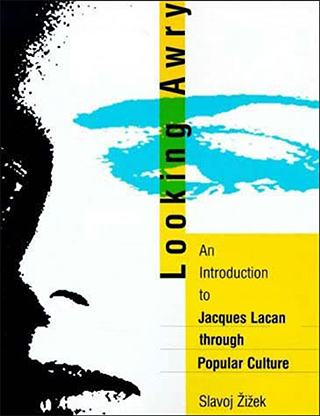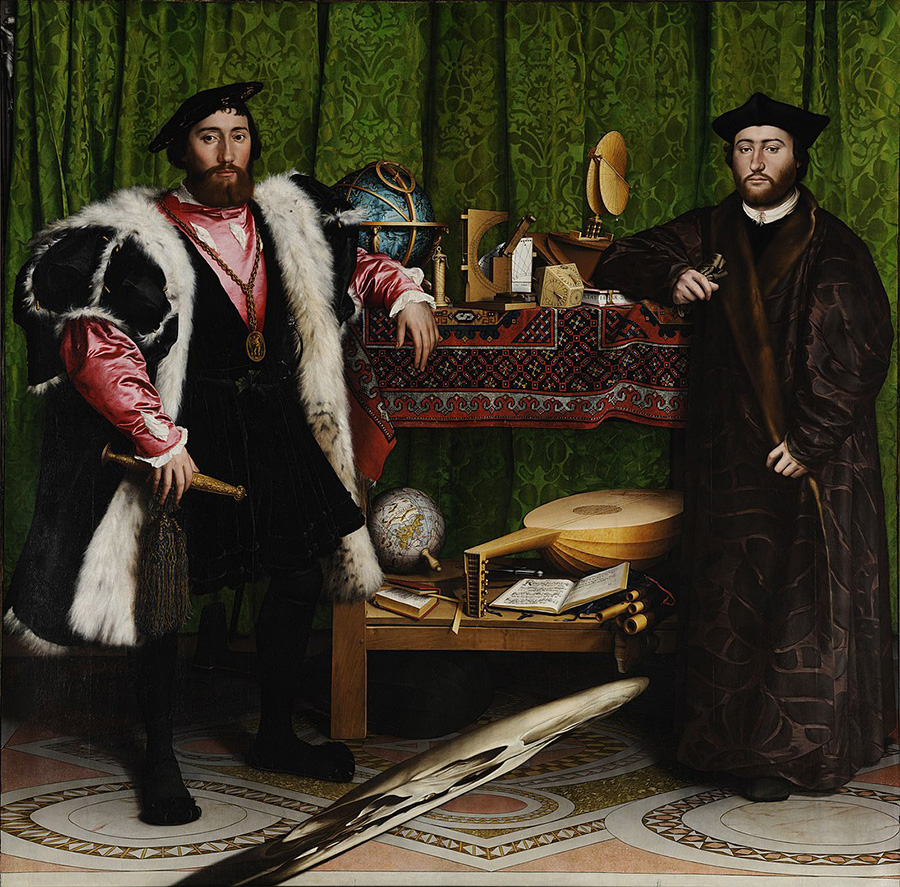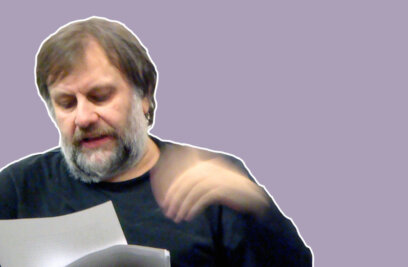Slavoj Žižek: The Phallic Anamorphoses

In the film “Foreign Correspondent,” there is a short scene that exemplifies what might be called the elementary cell, the basic matrix of the Hitchcockian procedure. In pursuit of the kidnappers of a diplomat, the hero finds himself in an idyllic Dutch countryside with fields of tulips and windmills. All of a sudden, he notices that one of the mills rotates against the direction of the wind.
Here we have the effect of what Jacques Lacan calls the point de capiton (the quilting point) in its purest: a perfectly natural and familiar situation is denatured, becomes “uncanny,” loaded with horror and threatening possibilities as soon as we add to it a small supplementary feature, a detail that does not belong, that sticks out, is out of place, and does not make any sense within the frame of the idyllic scene. This “pure” signifier without signified stirs the germination of a supplementary, metaphorical meaning for all other elements: the same situations, the same events that, till then, have been perceived as perfectly ordinary acquire an air of strangeness. Suddenly we enter the realm of double meaning, where everything seems to contain some hidden meaning that is to be interpreted by the Hitchcockian hero, “the man who knows too much.” The horror is thus internalized; it reposes on the gaze of him who “knows too much.”1

Hitchcock is often reproached for his “phallocentrism”; although meant as a criticism, this designation is quite adequate, on condition that we locate the phallic dimension precisely in this supplementary feature that “sticks out.” To explain, let us articulate three successive ways of presenting an event onscreen, three ways that correspond to the succession of “oral,” “anal,” and “phallic” stages in the subject’s libidinal economy.
The “oral” stage is, so to speak, the zero degree of filmmaking: We simply shoot an event, and as spectators we “devour it with our eyes”; the montage has no function in organizing narrative tensions. Its prototype is the silent, slapstick film. The effect of “naturalness,” of direct rendering of reality, is, of course, false: Even at this stage, a certain choice is at work, part of reality is enframed and extracted from the spacetime continuum. What we see is the result of a certain manipulation; the succession of shots partakes of a metonymical movement. We see only parts, fragments of a never-shown whole, which is why we are already caught in a dialectic of seen and unseen, of the field (enframed by the camera) and its outside, giving rise to the desire to see what is not shown. For all that, we remain captive of the illusion that we witness a homogeneous continuity of action registered by the “neutral” camera.
In the “anal” stage, montage enters. It cuts up, fragments, and multiplies the action; the illusion of homogeneous continuity is forever lost. Montage can combine elements of a wholly heterogeneous nature and thus create new metaphorical meaning having nothing whatsoever to do with the “literal” value of its component parts (compare Eisenstein’s concept of “intellectual montage”). The exemplary display of what montage can achieve at the level of traditional narration is, of course, the case of “parallel montage”: We show in alternation two interconnected courses of action, transforming the linear deployment of events into the horizontal coexistence of two lines of action, thus creating an additional tension between the two.
Let us take, for example, a scene depicting the isolated home of a rich family encircled by a gang of robbers preparing to attack it; the scene gains enormously in effectiveness if we contrast the idyllic everyday life within the house with the threatening preparations of the criminals outside: if we show in alternation the happy family at dinner, the boisterousness of the children, father’s benevolent reprimands, etc., and the sadistic smile of a robber, another checking his knife or gun, a third already grasping the house’s balustrade.
In what would the passage to the “phallic” stage consist? In other words, how would Hitchcock shoot the same scene? The first thing to remark is that the content of this scene does not lend itself to Hitchcockian suspense insofar as it rests upon a simple counterpoint of idyllic interior and threatening exterior. We should therefore transpose this “flat,” horizontal doubling of the action onto a vertical level: the menacing horror should not be placed outside, next to the idyllic interior, but well within it, more precisely: under it, as its repressed underside.
Let us imagine, for example, the same happy family dinner shown from the point of view of a rich uncle, their invited guest. In the midst of dinner, the guest (and together with him, we, the public) suddenly “sees too much,” observes what he was not supposed to notice, some incongruous detail arousing in him the suspicion that the hosts plan to poison him in order to inherit his fortune. Such a “surplus knowledge” has, so to speak, an abyssal effect on the perspective of the host (and ours with it): The action is in a way redoubled in itself, endlessly reflected in itself as in a double mirror play. The most common, everyday events are suddenly loaded with terrifying undertones, everything becomes suspicious: The kind mistress of the house asking if we feel well after dinner wants perhaps to learn if the poison has already taken effect; the children who run around in innocent joy are perhaps excited because the parents have hinted that they would soon be able to afford a luxurious voyage… Things appear in a totally different light, although they stay the same.
Incomparably more threatening than the savage cries of the enemy is his calm and cold gaze.
Such a “vertical” doubling entails a radical change in the libidinal economy: The “true” action is repressed, internalized, subjectivized, i.e., presented in the form of the subject’s desires, hallucinations, suspicions, obsessions, feelings of guilt. What we actually see becomes nothing but a deceptive surface beneath which swarms an undergrowth of perverse and obscene implications, the domain of what is prohibited. The more we find ourselves in total ambiguity, not knowing where “reality” ends and “hallucination” (i.e., desire) begins, the more menacing this domain appears. Incomparably more threatening than the savage cries of the enemy is his calm and cold gaze, or — to transpose the same inversion into the field of sexuality — incomparably more exciting than the openly provocative brunette is the cold blonde who, as Hitchcock reminds us, knows how to do many things once we find ourselves alone with her in the back seat of a taxi. What is crucial here is this inversion by means of which silence begins to function as the most horrifying menace, where the appearance of a cold indifference promises the most passionate pleasures — in short, where the prohibition against passing over into action opens up the space of a hallucinatory desire that, once set off, cannot be satisfied by any “reality” whatsoever.

But what has this inversion to do with the “phallic” stage? “Phallic” is precisely the detail that “does not fit,” that “sticks out” from the idyllic surface scene and denatures it, rendering it uncanny. It is the point of anamorphosis in a picture: the element that, when viewed straightforwardly, remains a meaningless stain, but which, as soon as we look at the picture from a precisely determined lateral perspective, suddenly acquires well-known contours.
Lacan’s constant point of reference is Holbein’s “Ambassadors”: At the bottom of the picture, under the figures of the two ambassadors, a viewer catches sight of an amorphous, extended, “erected” spot. It is only when, on the very threshold of the room in which the picture is exposed, the visitor casts a final lateral glance at it that this spot acquires the contours of a skull, disclosing thus the true meaning of the picture — the nullity of all terrestrial goods, objects of art and knowledge that fill out the rest of the picture.
This is the way Lacan defines the phallic signifier, as a “signifier without signified” which, as such, renders possible the effects of the signified: The “phallic” element of a picture is a meaningless stain that denatures it, rendering all its constituents suspicious, and thus opens up the abyss of the search for a meaning — nothing is what it seems to be, everything is to be interpreted, everything is supposed to possess some supplementary meaning. The ground of the established, familiar signification opens up; we find ourselves in a realm of total ambiguity, but this very lack propels us to produce ever-new “hidden meanings”: It is a driving force of endless compulsion. The oscillation between lack and surplus meaning constitutes the proper dimension of subjectivity.
In other words, it is by means of the “phallic” spot that the observed picture is subjectivized: This paradoxical point undermines our position as “neutral,” “objective” observer, pinning us to the observed object itself. This is the point at which the observer is already included, inscribed in the observed scene-in a way, it is the point from which the picture itself looks back at us.2
Slavoj Žižek is a philosopher and cultural critic, and the author of more than 30 books, including several published by the MIT Press (among them, “The Parallax View,” “Incontinence of the Void,” “The Puppet and the Dwarf,” “Žižek’s Jokes” and “Looking Awry,” from which this article is excerpted.
From this perspective, the denouement of “Dial M for Murder” is extremely interesting insofar as it reverses the usual situation of Hitchcock’s films: “The man who knew too much” is not the hero foreboding some terrifying secret behind the idyllic surface, but the murderer himself. That is to say, the inspector traps the murderous husband of Grace Kelly through a certain surplus knowledge — the murderer is caught knowing something that it would not be possible for him to know if he were innocent (the hiding place of the other key to his apartment).
The irony of the denouement is that what provokes the downfall of the murderer is precisely his quick and clever reasoning. If he had been just a little bit more slow-witted, i.e., if, after the key in his jacket had failed to open the door to his apartment, he had been unable to deduce quickly what must have happened, he would have been forever safe from the hand of justice. In the way he sets the trap for the murder, the inspector acts like a real Lacanian analyst: The crucial ingredient of his success is not his ability to “penetrate the other,” to understand him, to adapt to his reasoning, but rather his capacity to take into account the structuring role of a certain object that circulates among the subjects and entangles them in a network that they cannot dominate — the key in “Dial M for Murder” (and in “Notorious”), the letter in Edgar Allen Poe’s “The Purloined Letter,” etc.
- We must be attentive to the diversity of the ways this motif of the “uncanny” detail is at work in Hitchcock’s films. Note just five of its variations:
•“Rope”: Here, we have the spot first (the traumatic act of murder) and then the idyllic everyday situation (the party) constructed to conceal it.
•”The Man Who Knew Too Much”: In a short scene in which the hero (James Stewart) makes his way to the taxidermist Ambrose Chappell, the street the hero traverses is depicted as charged with a sinister atmosphere; but in fact things are precisely what they seem to be (the street is just an ordinary suburban London street, etc.), so that the only “stain” in the picture is the hero himself, his suspicious gaze that sees threats everywhere
•”The Trouble with Harry”: A “stain” (a body) smears the idyllic Vermont countryside, but instead of provoking traumatic reactions, people who stumble upon it merely treat it as a minor inconvenience and pursue their daily affairs.•“Shadow of a Doubt”: The “stain” here is uncle Charlie, the film’s central character, a pathological murderer who rejoins his sister’s family in a small American town. In the eyes of the townsfolk, he is a friendly, rich benefactor; it is only his niece Charlie who “knows too much” and sees him as he is — why? The answer is found in the identity of their names: the two of them constitute two parts of the same personality (like Marion and Norman in “Psycho,” where the identity is indicated by the fact that the two names reflect each other in an inverted form).
•And finally “The Birds,” where — in what is surely Hitchcock’s final irony — the “unnatural” element that disturbs everyday life is the birds, i.e., nature itself.

